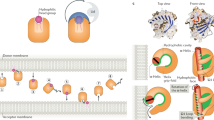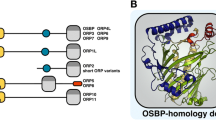Abstract
Cytosolic long-chain fatty acid binding proteins (FABPs) are found in tissues that metabolize fatty acids. Like most lipid binding proteins, their specific functions remain unclear. Two classes have been described. Membrane-active FABPs interact directly with membranes during exchange of fatty acids between the protein binding site and the membrane, while membrane-inactive FABPs bind only to fatty acids that are already in aqueous solution. Despite these binding proteins, most fatty acids in cell cytoplasm appear to be bound to membranes. This paper reviews data suggesting that FABPs catalyze transfer of fatty acids between intracellular membranes, often across considerable intracellular distances. This process occurs in three distinct steps: dissociation of the fatty acid from a ‘donor’ membrane, diffusion of the fatty acid across the intervening water layer, and binding to an ‘acceptor’ membrane. Membrane-active FABPs catalyze dissociation of the fatty acid from the donor membrane and binding to the acceptor membrane, while membrane-inactive FABPs catalyze diffusion of fatty acids across the aqueous cytosol. Thus, FABPs catalyze all three steps in intracellular transport. A simple quantitative model has been developed that predicts the rate of intracellular transport as a function of the concentration, affinity and diffusional mobility of the binding protein. Different FABPs may have evolved to match the specific transport requirements of the cell type within which they are found.
Similar content being viewed by others
References
Bernlohr DA, Coe NR, LiCata VJ: Fatty acid trafficking in the adipocyte. Semin Cell Dev Biol 10: 43–49, 1999
Glatz JFC, van der Vusse GJ: Cellular fatty acid-binding proteins: Their function and physiological significance. Prog Lipid Res 35: 243–282, 1996
Bass NM, Kaikaus RM, Ockner RK: Physiology and molecular biology of hepatic cytosolic fatty acid-binding protein. In: N. Tavoloni, P. D. Berk (eds). Hepatic Transport and Bile Secretion: Physiology and Pathophysiology. Raven Press, New York, 1993, pp 421–446
Ockner RK, Kaikaus RM, Bass NM: Fatty acid binding proteins: Recent concepts of regulation and function. Prog Clin Biol Res 375: 189–204, 1992
Tipping E, Ketterer B: The influence of soluble binding proteins on lipophile transport and metabolism in hepatocytes. Biochem J 195: 441–452, 1981
Weisiger RA: When is a carrier not a membrane carrier? The cytoplasmic transport of amphipathic molecules. Hepatology 24: 1288–1295, 1996
Zucker SD, Goessling W, Gollan JL: Intracellular transport of small hydrophobic compounds by the hepatocyte. Semin Liver Dis 16: 159–167, 1996
Storch J, Thumser AE: The fatty acid transport function of fatty acidbinding proteins. Biochim Biophys Acta 55624: 1–17, 2000
Binas B, Danneberg H, McWhir J, Mullins L, Clark AJ: Requirement for the heart-type fatty acid binding protein in cardiac fatty acid utilization. FASEB J 13: 805–812, 1999
Baier LJ, Sacchettini JC, Knowler WC, Eads J, Paolisso G, Tataranni PA, Mochizuki H, Bennett PH, Bogardus C, Prochazka M: An amino acid substitution in the human intestinal fatty acid binding protein is associated with increased fatty acid binding, increased fat oxidation, and insulin resistance. J Clin Invest 95: 1281–1287, 1995
Renaud G, Foliot A, Infante R: Increased uptake of fatty acids by the isolated rat liver after raising the fatty acid binding protein concentration with clofibrate. Biochem Biophys Res Commun 80: 327–334, 1978
Capuzzi DM, Lackman RD, Uberti MO, Reed MA: Stimulation of hepatic triglyceride synthesis and secretion by clofibrate. Biochem Biophys Res Commun 60: 1499–1508, 1974
Murphy EJ: L-FABP and I-FABP expression increase NBD-stearate uptake and cytoplasmic diffusion in L cells. Am J Physiol 275: G244–G249, 1998
Burczynski FJ, Fandrey S, Wang G, Pavletic PA, Gong Y: Cytosolic fatty acid binding protein enhances rat hepatocyte [3H]palmitate uptake. Can J Physiol Pharmacol 77: 896–901, 1999
Baier LJ, Bogardus C, Sacchettini JC: A polymorphism in the human intestinal fatty acid binding protein alters fatty acid transport across Caco-2 cells. J Biol Chem 271: 10892–10896, 1996
Prows DR, Murphy EJ, Moncecchi D, Schroeder F: Intestinal fatty acid-binding protein expression stimulates fibroblast fatty acid esterification. Chem Phys Lipids 84: 47–56, 1996
Murphy EJ, Prows DR, Jefferson JR, Schroeder F: Liver fatty acidbinding protein expression in transfected fibroblasts stimulates fatty acid uptake and metabolism. Biochim Biophys Acta 1301: 191–198, 1996
Atshaves BP, Foxworth WB, Frolov A, Roths JB, Kier AB, Oetama BK, Piedrahita JA, Schroeder F: Cellular differentiation and I-FABP protein expression modulate fatty acid uptake and diffusion. Am J Physiol 274: C633–C644, 1998
Wolfrum C, Buhlmann C, Rolf B, Borchers T, Spener F: Variation of liver-type fatty acid binding protein content in the human hepatoma cell line HepG2 by peroxisome proliferators and antisense RNA affects the rate of fatty acid uptake. Biochim Biophys Acta 1437: 194–201, 1999
Darimont C, Gradoux N, Persohn E, Cumin F, De Pover A: Effects of intestinal fatty acid-binding protein overexpression on fatty acid metabolism in Caco-2 cells. J Lipid Res 41: 84–92, 2000
Ockner RK, Manning JA: Fatty acid binding protein. Role in esterification of absorbed long chain fatty acid in rat intestine. J Clin Invest 58: 632–641, 1976
Wu-Rideout MYC, Elson C, Shrago E: The role of fatty acid binding protein on the metabolism of fatty acids in isolated rat hepatocytes. Biochem Biophys Res Commun 71: 809–816, 1976
Memon RA, Bass NM, Moser AH, Fuller J, Appel R, Grunfeld C, Feingold KR: Down-regulation of liver and heart specific fatty acid binding proteins by endotoxin and cytokines in vivo. Biochim Biophys Acta 1440: 118–126, 1999
Luxon BA, Milliano MT: Cytoplasmic transport of fatty acids in rat enterocytes: Role of binding to fatty acid-binding protein. Am J Physiol 277: G361–G366, 1999
Luxon BA, Milliano MT: Facilitation of cytoplasmic transport of fatty acids via co-diffusion is not specific for fatty acid binding protein. Am J Physiol 273: C859–C867, 1997
Luxon BA: Inhibition of binding to fatty acid binding protein reduces the intracellular transport of a fatty acids. Am J Physiol 271: G113–G120, 1996
Luxon BA, Holly DC, Milliano MC, Weisiger RA: Sex differences in multiple steps in the hepatic transport of palmitate support a balanced uptake mechanism. Am J Physiol 274: G52–G61, 1998
Vorum H, Brodersen R, Kragh-Hansen U, Pedersen AO: Solubility of long-chain fatty acids in phosphate buffer at pH 7.4. Biochim Biophys Acta Lipids Lipid Metab 1126: 135–142, 1992
Richieri GV, Ogata RT, Kleinfeld AM: Thermodynamics of fatty acid binding to fatty acid-binding proteins and fatty acid partition between water and membranes measured using the fluorescent probe ADIFAB. J Biol Chem 270: 15076–15084, 1995
Luxon BA, Weisiger RA: Sex differences in intracellular fatty acid transport: Role of cytoplasmic binding proteins. Am J Physiol 265: G831–G841, 1993
Katz N: Metabolism of lipids. In: R.G. Thurman, F.C. Kauffman, K. Jungermann (eds). Regulation of Hepatic Metabolism: Intra-and Intercellular Compartmentation. Plenum Press, New York, 1986, pp 237–253
Gericke A, Smith ER, Moore DJ, Mendelsohn R, Storch J: Adipocyte fatty acid-binding protein: Interaction with phospholipid membranes and thermal stability studied by FTIR spectroscopy. Biochemistry 36: 8311–8317, 1997
Herr FM, Aronson J, Storch J: Role of portal region lysine residues in electrostatic interactions between heart fatty acid binding protein and phospholipid membranes. Biochemistry 35: 1296–1303, 1996
Hsu KT, Storch J: Fatty acid transfer from liver and intestinal fatty acidbinding proteins to membranes occurs by different mechanisms. J Biol Chem 271: 13317–13323, 1996
Kim HK, Storch J: Mechanism of free fatty acid transfer from rat heart fatty acid-binding protein to phospholipid membranes. Evidence for a collisional process. J Biol Chem 267: 20051–20056, 1992
Thumser AE, Storch J: Liver and intestinal fatty acid-binding proteins obtain fatty acids from phospholipid membranes by different mechanisms. J Lipid Res 41: 647–656, 2000
Herr FM, Matarese V, Bernlohr DA, Storch J: Surface lysine residues modulate the collisional transfer of fatty acid from adipocyte fatty acid binding protein to membranes. Biochemistry 34: 11840–11845, 1995
Corsico B, Cistola DP, Frieden C, Storch J: The helical domain of intestinal fatty acid binding protein is critical for collisional transfer of fatty acids to phospholipid membranes. Proc Natl Acad Sci USA 95: 12174–12178, 1998
Weisiger RA, Zucker SD: Transfer of small molecules between intracellular membranes: Roles of soluble binding proteins, distance and time. Am J Physiol 2002 (in press)
Kleinfeld AM, Chu P, Romero C: Transport of long-chain native fatty acids across lipid bilayer membranes indicates that transbilayer flipflop is rate limiting. Biochemistry 36: 14146–14158, 1997
Fick A: Ñber diffusion. Ann Physik 94: 59–86, 1855.
Weisiger RA: Cytoplasmic transport of lipids: Role of binding proteins. Comp Biochem Physiol 115B: 319–331, 1996
Scow RO, Blanchette-Mackie EJ, Smith LC: Role of capillary endothelium in the clearance of chylomicrons: A model for lipid transport. Circ Res 49: 149–162, 1976
Crawford JM, Gollan JL: Transcellular transport of organic anions in hepatocytes: Still a long way to go. Hepatology 14: 192–197, 1991
Luxon BA, Milliano MT, Weisiger RA: Induction of hepatic cytosolic fatty acid binding protein with clofibrate accelerates both membrane and cytoplasmic transport of palmitate. Biochim Biophys Acta 1487: 309–318, 2000
Weisiger RA: Saturable stimulation of fatty acid transport through model cytoplasm by soluble binding protein. Am J Physiol 277: G109–G119, 1999
Author information
Authors and Affiliations
Rights and permissions
About this article
Cite this article
Weisiger, R.A. Cytosolic fatty acid binding proteins catalyze two distinct steps in intracellular transport of their ligands. Mol Cell Biochem 239, 35–43 (2002). https://doi.org/10.1023/A:1020550405578
Issue Date:
DOI: https://doi.org/10.1023/A:1020550405578




